Integrated Infrastructure Project: New Royal Adelaide Hospital Report
VerifiedAdded on 2020/03/02
|15
|3112
|83
Report
AI Summary
This report provides a comprehensive analysis of the Integrated Infrastructure Project Management of the New Royal Adelaide Hospital (RAH). It is divided into two main parts: Part 3 focuses on the commissioning steps, including the involvement of the Calcutta Group, the establishment of a new RAH Program, contract handover and sign-off procedures, and infrastructure maintenance issues within the Public-Private Partnership (PPP) model. It also discusses strategic planning for maintenance, techniques for maintenance management, and best practices under asset management. Part 4 delves into operational issues, including risk management, safety and security measures, and the efficiency of project leadership. The report highlights strategies and recommendations for addressing operational challenges, the methodology utilized, the response from management, and techniques adapted for safety management. It also includes an executive summary, a table of contents, and references, providing a detailed overview of the project's complexities and management strategies.
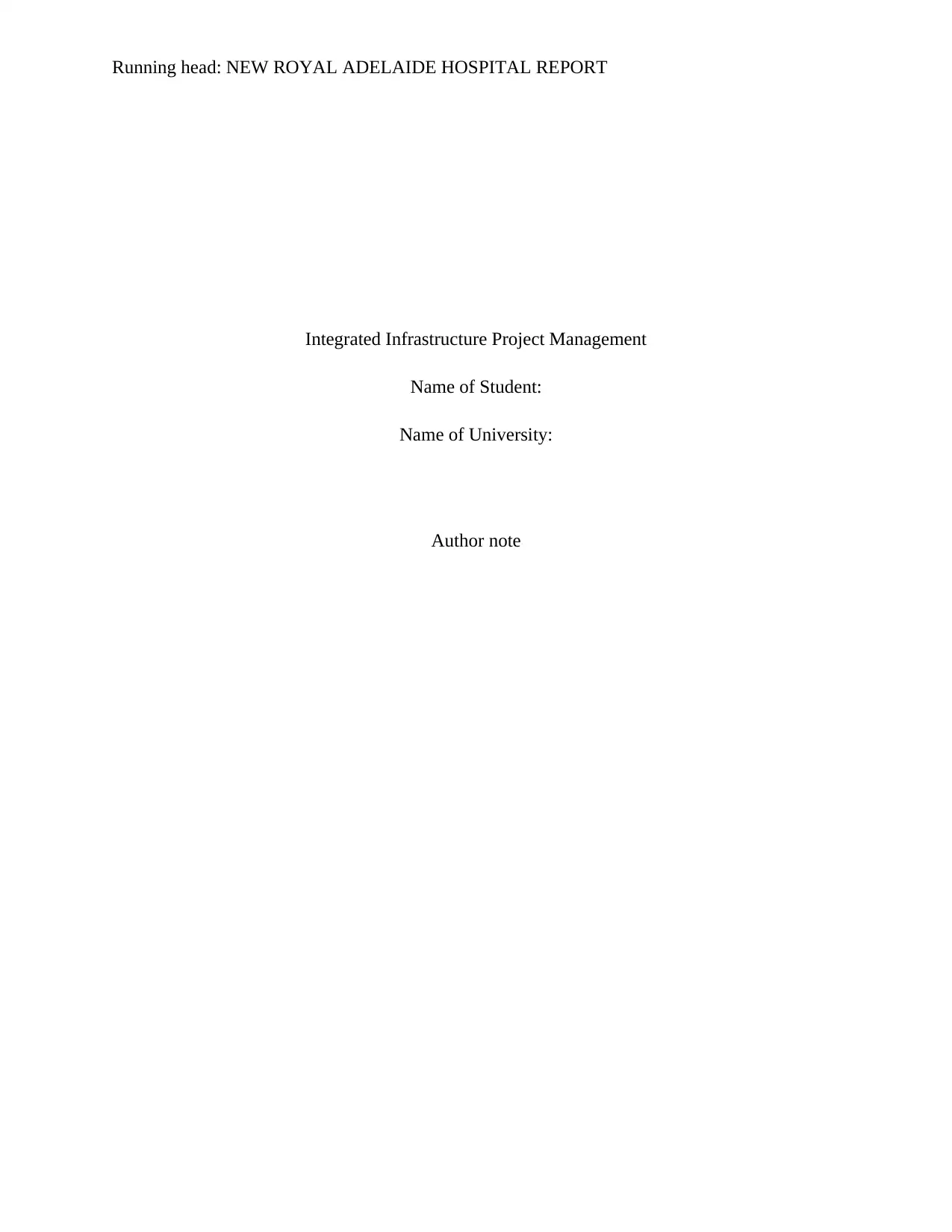
Running head: NEW ROYAL ADELAIDE HOSPITAL REPORT
Integrated Infrastructure Project Management
Name of Student:
Name of University:
Author note
Integrated Infrastructure Project Management
Name of Student:
Name of University:
Author note
Paraphrase This Document
Need a fresh take? Get an instant paraphrase of this document with our AI Paraphraser
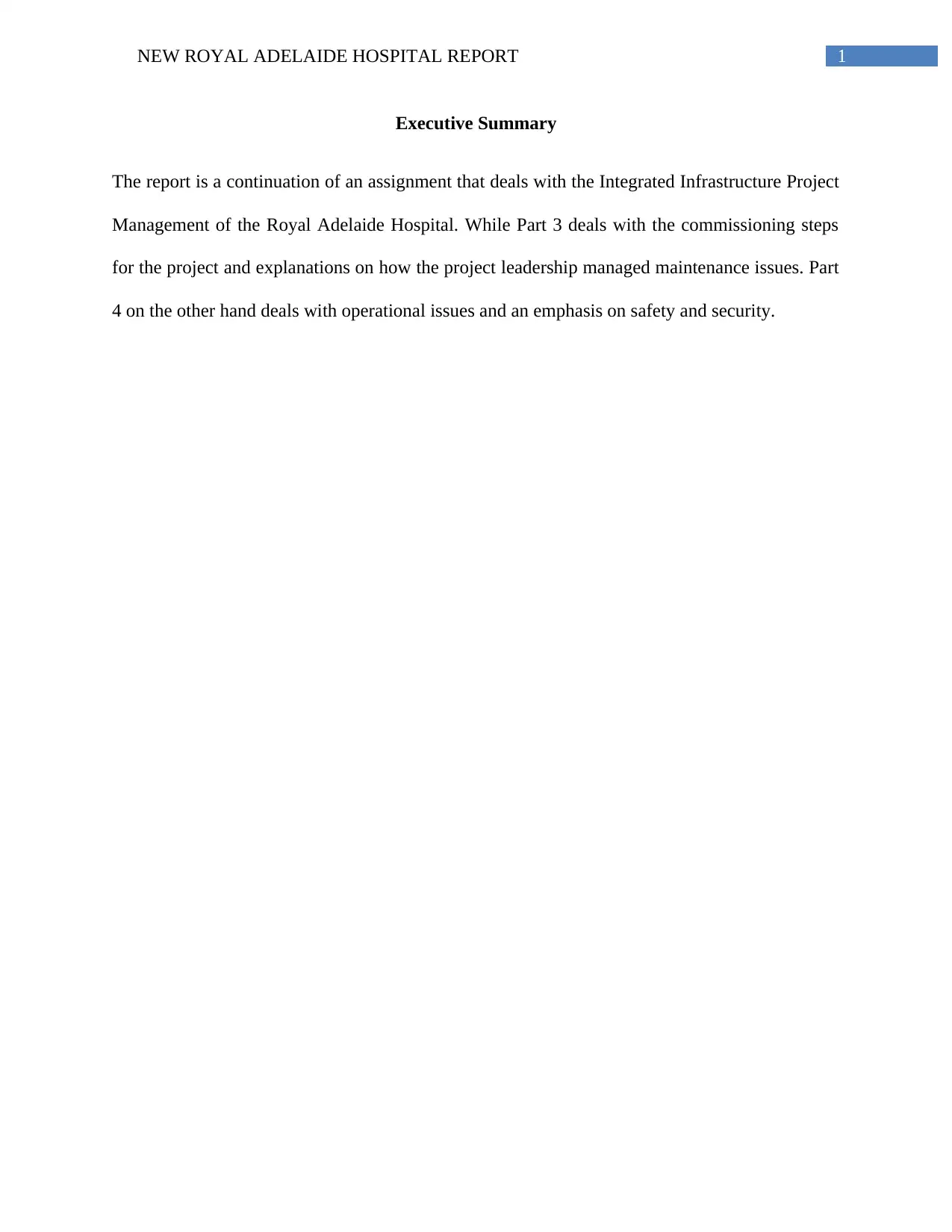
1NEW ROYAL ADELAIDE HOSPITAL REPORT
Executive Summary
The report is a continuation of an assignment that deals with the Integrated Infrastructure Project
Management of the Royal Adelaide Hospital. While Part 3 deals with the commissioning steps
for the project and explanations on how the project leadership managed maintenance issues. Part
4 on the other hand deals with operational issues and an emphasis on safety and security.
Executive Summary
The report is a continuation of an assignment that deals with the Integrated Infrastructure Project
Management of the Royal Adelaide Hospital. While Part 3 deals with the commissioning steps
for the project and explanations on how the project leadership managed maintenance issues. Part
4 on the other hand deals with operational issues and an emphasis on safety and security.
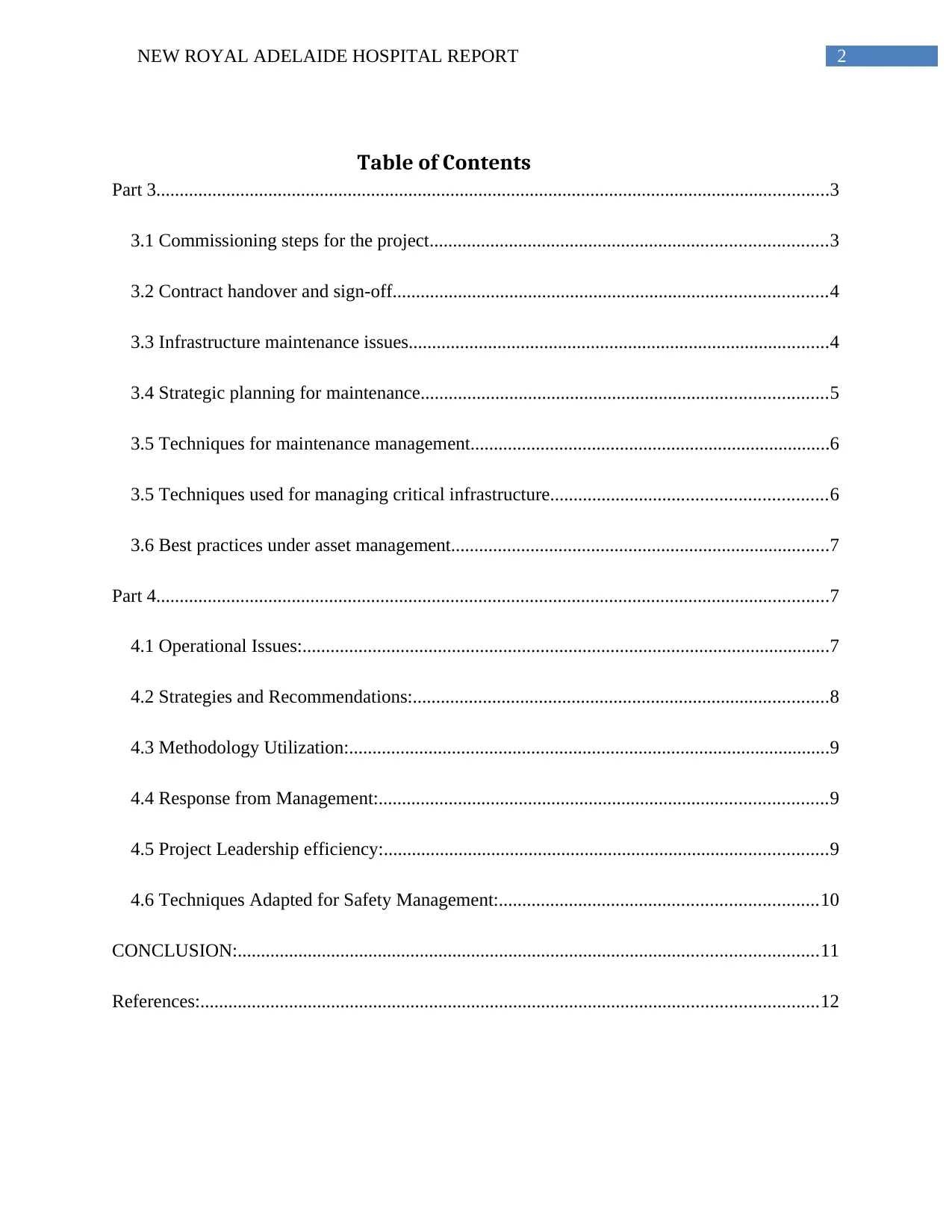
2NEW ROYAL ADELAIDE HOSPITAL REPORT
Table of Contents
Part 3................................................................................................................................................3
3.1 Commissioning steps for the project.....................................................................................3
3.2 Contract handover and sign-off.............................................................................................4
3.3 Infrastructure maintenance issues..........................................................................................4
3.4 Strategic planning for maintenance.......................................................................................5
3.5 Techniques for maintenance management.............................................................................6
3.5 Techniques used for managing critical infrastructure...........................................................6
3.6 Best practices under asset management.................................................................................7
Part 4................................................................................................................................................7
4.1 Operational Issues:.................................................................................................................7
4.2 Strategies and Recommendations:.........................................................................................8
4.3 Methodology Utilization:.......................................................................................................9
4.4 Response from Management:................................................................................................9
4.5 Project Leadership efficiency:...............................................................................................9
4.6 Techniques Adapted for Safety Management:....................................................................10
CONCLUSION:............................................................................................................................11
References:....................................................................................................................................12
Table of Contents
Part 3................................................................................................................................................3
3.1 Commissioning steps for the project.....................................................................................3
3.2 Contract handover and sign-off.............................................................................................4
3.3 Infrastructure maintenance issues..........................................................................................4
3.4 Strategic planning for maintenance.......................................................................................5
3.5 Techniques for maintenance management.............................................................................6
3.5 Techniques used for managing critical infrastructure...........................................................6
3.6 Best practices under asset management.................................................................................7
Part 4................................................................................................................................................7
4.1 Operational Issues:.................................................................................................................7
4.2 Strategies and Recommendations:.........................................................................................8
4.3 Methodology Utilization:.......................................................................................................9
4.4 Response from Management:................................................................................................9
4.5 Project Leadership efficiency:...............................................................................................9
4.6 Techniques Adapted for Safety Management:....................................................................10
CONCLUSION:............................................................................................................................11
References:....................................................................................................................................12
⊘ This is a preview!⊘
Do you want full access?
Subscribe today to unlock all pages.

Trusted by 1+ million students worldwide
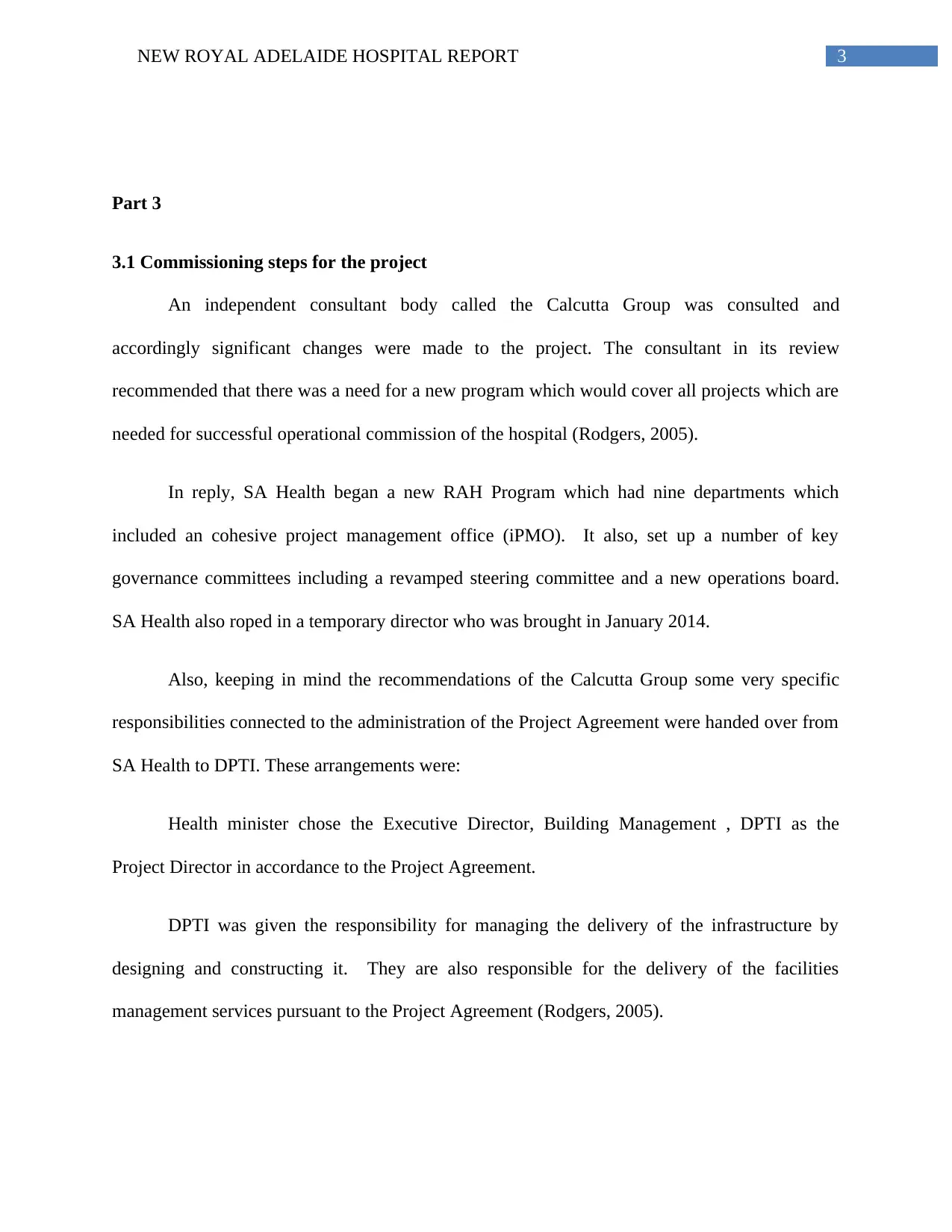
3NEW ROYAL ADELAIDE HOSPITAL REPORT
Part 3
3.1 Commissioning steps for the project
An independent consultant body called the Calcutta Group was consulted and
accordingly significant changes were made to the project. The consultant in its review
recommended that there was a need for a new program which would cover all projects which are
needed for successful operational commission of the hospital (Rodgers, 2005).
In reply, SA Health began a new RAH Program which had nine departments which
included an cohesive project management office (iPMO). It also, set up a number of key
governance committees including a revamped steering committee and a new operations board.
SA Health also roped in a temporary director who was brought in January 2014.
Also, keeping in mind the recommendations of the Calcutta Group some very specific
responsibilities connected to the administration of the Project Agreement were handed over from
SA Health to DPTI. These arrangements were:
Health minister chose the Executive Director, Building Management , DPTI as the
Project Director in accordance to the Project Agreement.
DPTI was given the responsibility for managing the delivery of the infrastructure by
designing and constructing it. They are also responsible for the delivery of the facilities
management services pursuant to the Project Agreement (Rodgers, 2005).
Part 3
3.1 Commissioning steps for the project
An independent consultant body called the Calcutta Group was consulted and
accordingly significant changes were made to the project. The consultant in its review
recommended that there was a need for a new program which would cover all projects which are
needed for successful operational commission of the hospital (Rodgers, 2005).
In reply, SA Health began a new RAH Program which had nine departments which
included an cohesive project management office (iPMO). It also, set up a number of key
governance committees including a revamped steering committee and a new operations board.
SA Health also roped in a temporary director who was brought in January 2014.
Also, keeping in mind the recommendations of the Calcutta Group some very specific
responsibilities connected to the administration of the Project Agreement were handed over from
SA Health to DPTI. These arrangements were:
Health minister chose the Executive Director, Building Management , DPTI as the
Project Director in accordance to the Project Agreement.
DPTI was given the responsibility for managing the delivery of the infrastructure by
designing and constructing it. They are also responsible for the delivery of the facilities
management services pursuant to the Project Agreement (Rodgers, 2005).
Paraphrase This Document
Need a fresh take? Get an instant paraphrase of this document with our AI Paraphraser
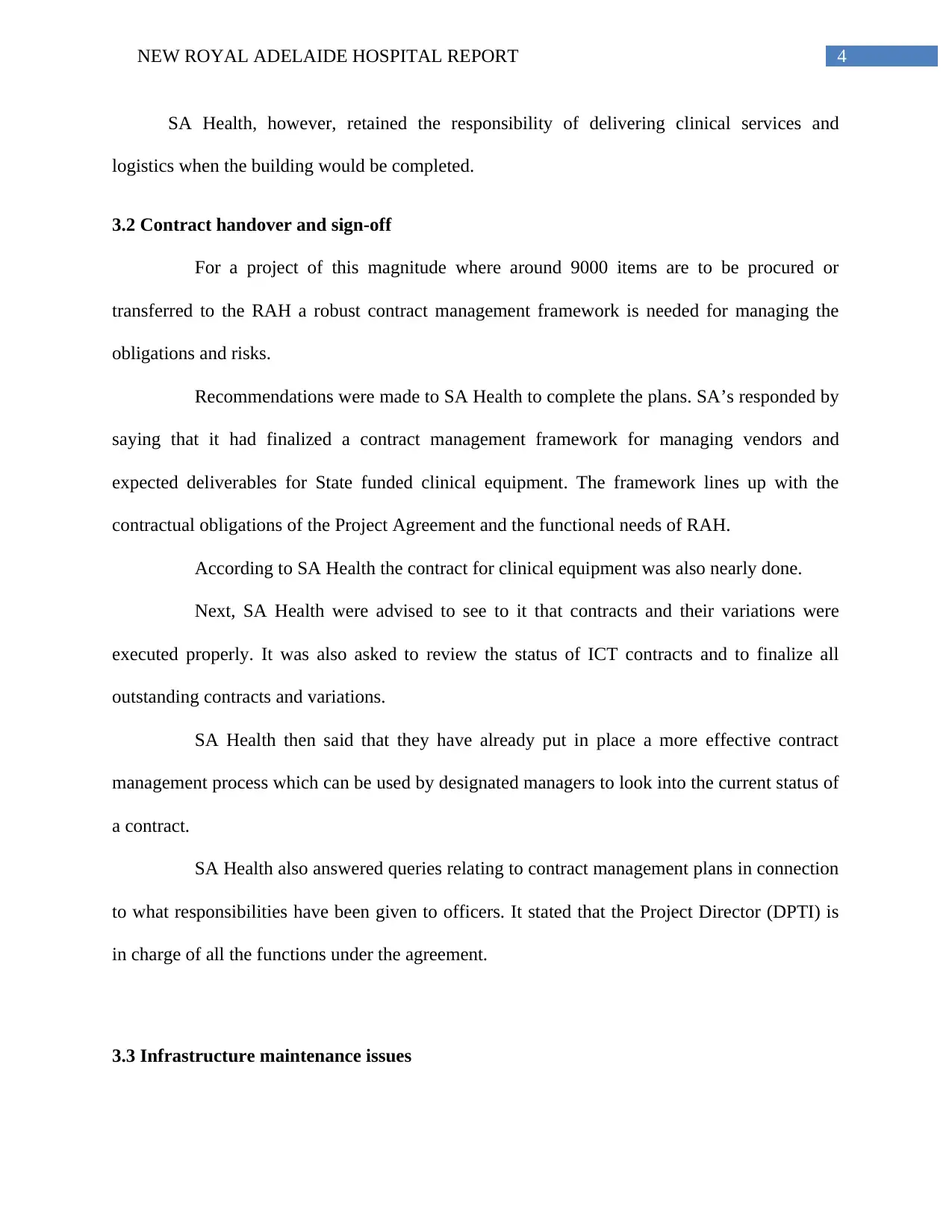
4NEW ROYAL ADELAIDE HOSPITAL REPORT
SA Health, however, retained the responsibility of delivering clinical services and
logistics when the building would be completed.
3.2 Contract handover and sign-off
For a project of this magnitude where around 9000 items are to be procured or
transferred to the RAH a robust contract management framework is needed for managing the
obligations and risks.
Recommendations were made to SA Health to complete the plans. SA’s responded by
saying that it had finalized a contract management framework for managing vendors and
expected deliverables for State funded clinical equipment. The framework lines up with the
contractual obligations of the Project Agreement and the functional needs of RAH.
According to SA Health the contract for clinical equipment was also nearly done.
Next, SA Health were advised to see to it that contracts and their variations were
executed properly. It was also asked to review the status of ICT contracts and to finalize all
outstanding contracts and variations.
SA Health then said that they have already put in place a more effective contract
management process which can be used by designated managers to look into the current status of
a contract.
SA Health also answered queries relating to contract management plans in connection
to what responsibilities have been given to officers. It stated that the Project Director (DPTI) is
in charge of all the functions under the agreement.
3.3 Infrastructure maintenance issues
SA Health, however, retained the responsibility of delivering clinical services and
logistics when the building would be completed.
3.2 Contract handover and sign-off
For a project of this magnitude where around 9000 items are to be procured or
transferred to the RAH a robust contract management framework is needed for managing the
obligations and risks.
Recommendations were made to SA Health to complete the plans. SA’s responded by
saying that it had finalized a contract management framework for managing vendors and
expected deliverables for State funded clinical equipment. The framework lines up with the
contractual obligations of the Project Agreement and the functional needs of RAH.
According to SA Health the contract for clinical equipment was also nearly done.
Next, SA Health were advised to see to it that contracts and their variations were
executed properly. It was also asked to review the status of ICT contracts and to finalize all
outstanding contracts and variations.
SA Health then said that they have already put in place a more effective contract
management process which can be used by designated managers to look into the current status of
a contract.
SA Health also answered queries relating to contract management plans in connection
to what responsibilities have been given to officers. It stated that the Project Director (DPTI) is
in charge of all the functions under the agreement.
3.3 Infrastructure maintenance issues
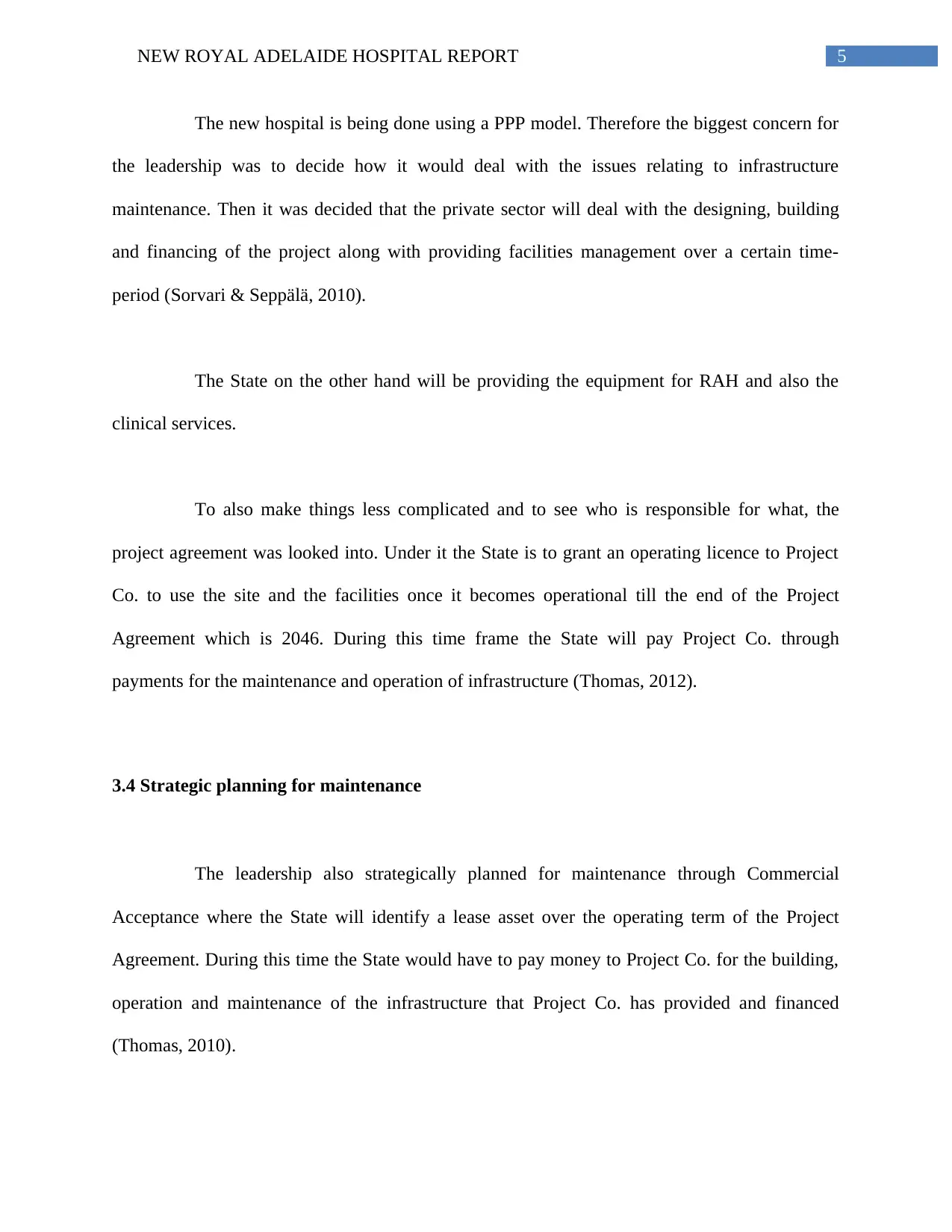
5NEW ROYAL ADELAIDE HOSPITAL REPORT
The new hospital is being done using a PPP model. Therefore the biggest concern for
the leadership was to decide how it would deal with the issues relating to infrastructure
maintenance. Then it was decided that the private sector will deal with the designing, building
and financing of the project along with providing facilities management over a certain time-
period (Sorvari & Seppälä, 2010).
The State on the other hand will be providing the equipment for RAH and also the
clinical services.
To also make things less complicated and to see who is responsible for what, the
project agreement was looked into. Under it the State is to grant an operating licence to Project
Co. to use the site and the facilities once it becomes operational till the end of the Project
Agreement which is 2046. During this time frame the State will pay Project Co. through
payments for the maintenance and operation of infrastructure (Thomas, 2012).
3.4 Strategic planning for maintenance
The leadership also strategically planned for maintenance through Commercial
Acceptance where the State will identify a lease asset over the operating term of the Project
Agreement. During this time the State would have to pay money to Project Co. for the building,
operation and maintenance of the infrastructure that Project Co. has provided and financed
(Thomas, 2010).
The new hospital is being done using a PPP model. Therefore the biggest concern for
the leadership was to decide how it would deal with the issues relating to infrastructure
maintenance. Then it was decided that the private sector will deal with the designing, building
and financing of the project along with providing facilities management over a certain time-
period (Sorvari & Seppälä, 2010).
The State on the other hand will be providing the equipment for RAH and also the
clinical services.
To also make things less complicated and to see who is responsible for what, the
project agreement was looked into. Under it the State is to grant an operating licence to Project
Co. to use the site and the facilities once it becomes operational till the end of the Project
Agreement which is 2046. During this time frame the State will pay Project Co. through
payments for the maintenance and operation of infrastructure (Thomas, 2012).
3.4 Strategic planning for maintenance
The leadership also strategically planned for maintenance through Commercial
Acceptance where the State will identify a lease asset over the operating term of the Project
Agreement. During this time the State would have to pay money to Project Co. for the building,
operation and maintenance of the infrastructure that Project Co. has provided and financed
(Thomas, 2010).
⊘ This is a preview!⊘
Do you want full access?
Subscribe today to unlock all pages.

Trusted by 1+ million students worldwide
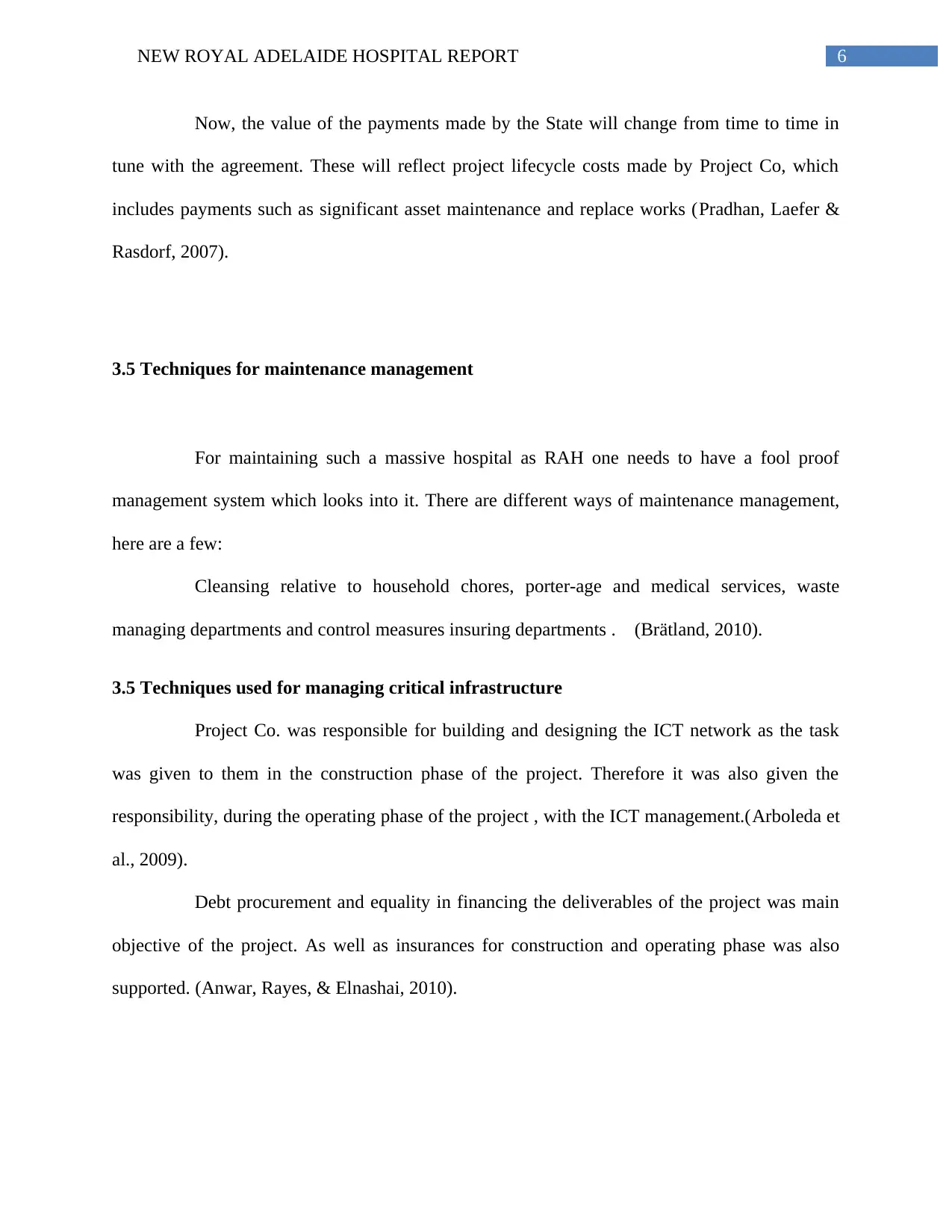
6NEW ROYAL ADELAIDE HOSPITAL REPORT
Now, the value of the payments made by the State will change from time to time in
tune with the agreement. These will reflect project lifecycle costs made by Project Co, which
includes payments such as significant asset maintenance and replace works (Pradhan, Laefer &
Rasdorf, 2007).
3.5 Techniques for maintenance management
For maintaining such a massive hospital as RAH one needs to have a fool proof
management system which looks into it. There are different ways of maintenance management,
here are a few:
Cleansing relative to household chores, porter-age and medical services, waste
managing departments and control measures insuring departments . (Brätland, 2010).
3.5 Techniques used for managing critical infrastructure
Project Co. was responsible for building and designing the ICT network as the task
was given to them in the construction phase of the project. Therefore it was also given the
responsibility, during the operating phase of the project , with the ICT management.(Arboleda et
al., 2009).
Debt procurement and equality in financing the deliverables of the project was main
objective of the project. As well as insurances for construction and operating phase was also
supported. (Anwar, Rayes, & Elnashai, 2010).
Now, the value of the payments made by the State will change from time to time in
tune with the agreement. These will reflect project lifecycle costs made by Project Co, which
includes payments such as significant asset maintenance and replace works (Pradhan, Laefer &
Rasdorf, 2007).
3.5 Techniques for maintenance management
For maintaining such a massive hospital as RAH one needs to have a fool proof
management system which looks into it. There are different ways of maintenance management,
here are a few:
Cleansing relative to household chores, porter-age and medical services, waste
managing departments and control measures insuring departments . (Brätland, 2010).
3.5 Techniques used for managing critical infrastructure
Project Co. was responsible for building and designing the ICT network as the task
was given to them in the construction phase of the project. Therefore it was also given the
responsibility, during the operating phase of the project , with the ICT management.(Arboleda et
al., 2009).
Debt procurement and equality in financing the deliverables of the project was main
objective of the project. As well as insurances for construction and operating phase was also
supported. (Anwar, Rayes, & Elnashai, 2010).
Paraphrase This Document
Need a fresh take? Get an instant paraphrase of this document with our AI Paraphraser
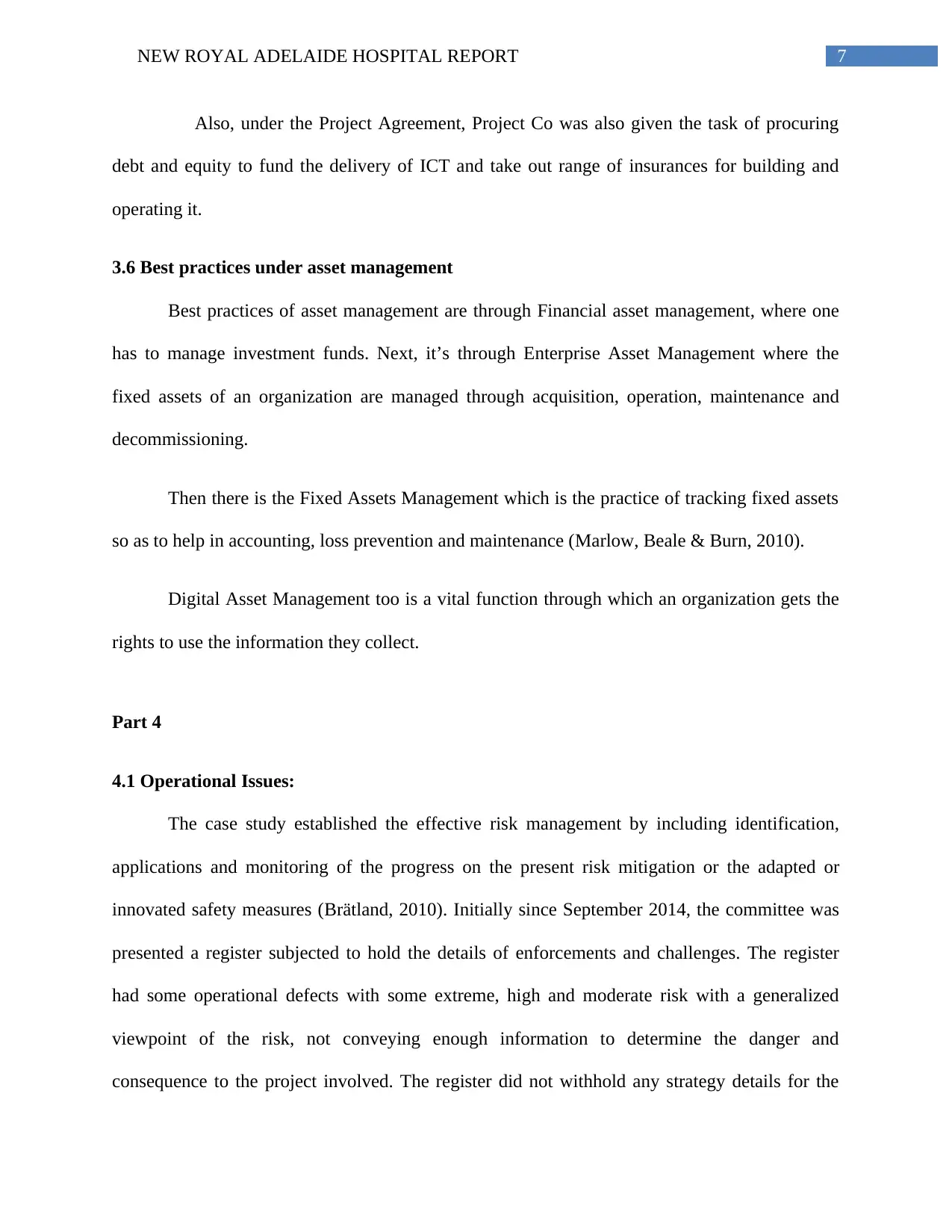
7NEW ROYAL ADELAIDE HOSPITAL REPORT
Also, under the Project Agreement, Project Co was also given the task of procuring
debt and equity to fund the delivery of ICT and take out range of insurances for building and
operating it.
3.6 Best practices under asset management
Best practices of asset management are through Financial asset management, where one
has to manage investment funds. Next, it’s through Enterprise Asset Management where the
fixed assets of an organization are managed through acquisition, operation, maintenance and
decommissioning.
Then there is the Fixed Assets Management which is the practice of tracking fixed assets
so as to help in accounting, loss prevention and maintenance (Marlow, Beale & Burn, 2010).
Digital Asset Management too is a vital function through which an organization gets the
rights to use the information they collect.
Part 4
4.1 Operational Issues:
The case study established the effective risk management by including identification,
applications and monitoring of the progress on the present risk mitigation or the adapted or
innovated safety measures (Brätland, 2010). Initially since September 2014, the committee was
presented a register subjected to hold the details of enforcements and challenges. The register
had some operational defects with some extreme, high and moderate risk with a generalized
viewpoint of the risk, not conveying enough information to determine the danger and
consequence to the project involved. The register did not withhold any strategy details for the
Also, under the Project Agreement, Project Co was also given the task of procuring
debt and equity to fund the delivery of ICT and take out range of insurances for building and
operating it.
3.6 Best practices under asset management
Best practices of asset management are through Financial asset management, where one
has to manage investment funds. Next, it’s through Enterprise Asset Management where the
fixed assets of an organization are managed through acquisition, operation, maintenance and
decommissioning.
Then there is the Fixed Assets Management which is the practice of tracking fixed assets
so as to help in accounting, loss prevention and maintenance (Marlow, Beale & Burn, 2010).
Digital Asset Management too is a vital function through which an organization gets the
rights to use the information they collect.
Part 4
4.1 Operational Issues:
The case study established the effective risk management by including identification,
applications and monitoring of the progress on the present risk mitigation or the adapted or
innovated safety measures (Brätland, 2010). Initially since September 2014, the committee was
presented a register subjected to hold the details of enforcements and challenges. The register
had some operational defects with some extreme, high and moderate risk with a generalized
viewpoint of the risk, not conveying enough information to determine the danger and
consequence to the project involved. The register did not withhold any strategy details for the
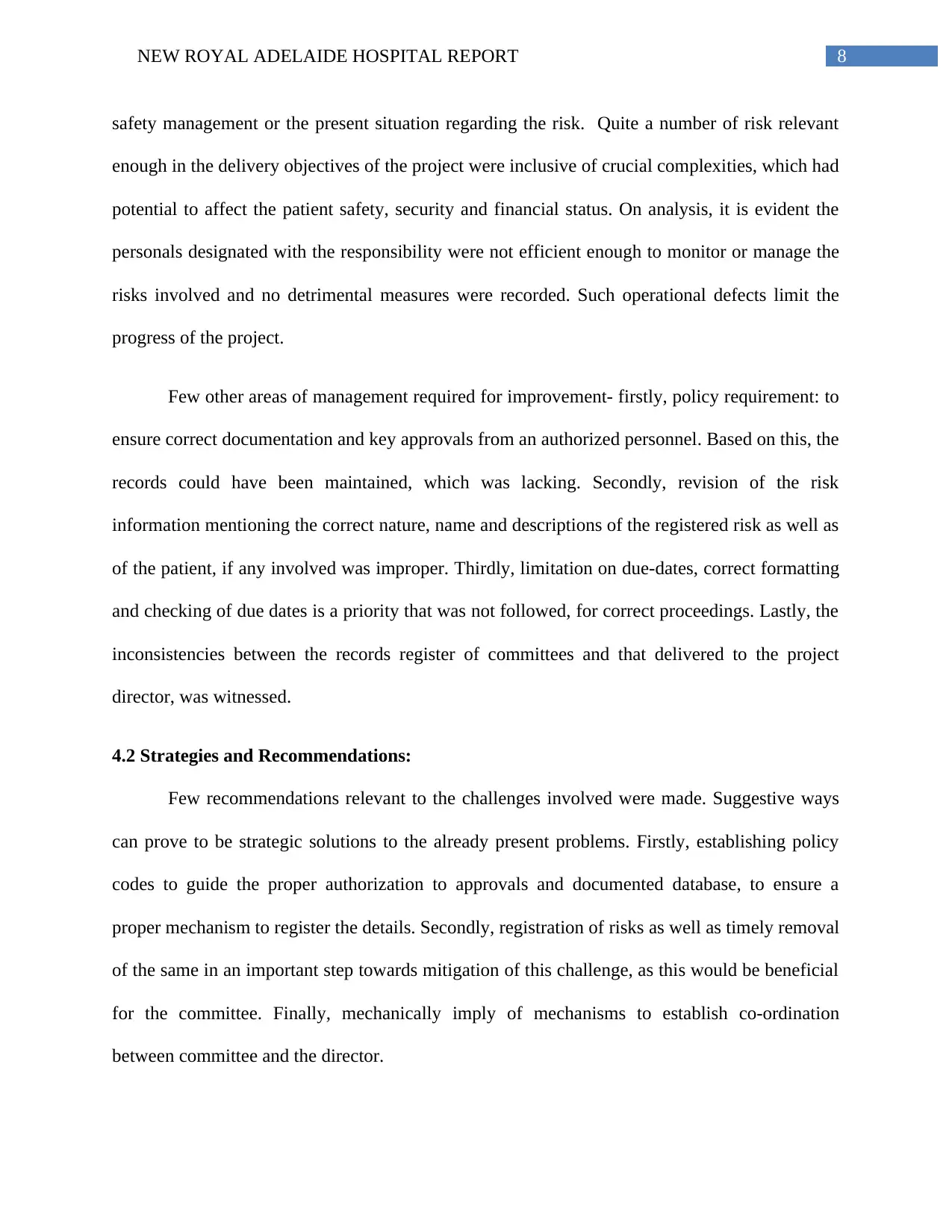
8NEW ROYAL ADELAIDE HOSPITAL REPORT
safety management or the present situation regarding the risk. Quite a number of risk relevant
enough in the delivery objectives of the project were inclusive of crucial complexities, which had
potential to affect the patient safety, security and financial status. On analysis, it is evident the
personals designated with the responsibility were not efficient enough to monitor or manage the
risks involved and no detrimental measures were recorded. Such operational defects limit the
progress of the project.
Few other areas of management required for improvement- firstly, policy requirement: to
ensure correct documentation and key approvals from an authorized personnel. Based on this, the
records could have been maintained, which was lacking. Secondly, revision of the risk
information mentioning the correct nature, name and descriptions of the registered risk as well as
of the patient, if any involved was improper. Thirdly, limitation on due-dates, correct formatting
and checking of due dates is a priority that was not followed, for correct proceedings. Lastly, the
inconsistencies between the records register of committees and that delivered to the project
director, was witnessed.
4.2 Strategies and Recommendations:
Few recommendations relevant to the challenges involved were made. Suggestive ways
can prove to be strategic solutions to the already present problems. Firstly, establishing policy
codes to guide the proper authorization to approvals and documented database, to ensure a
proper mechanism to register the details. Secondly, registration of risks as well as timely removal
of the same in an important step towards mitigation of this challenge, as this would be beneficial
for the committee. Finally, mechanically imply of mechanisms to establish co-ordination
between committee and the director.
safety management or the present situation regarding the risk. Quite a number of risk relevant
enough in the delivery objectives of the project were inclusive of crucial complexities, which had
potential to affect the patient safety, security and financial status. On analysis, it is evident the
personals designated with the responsibility were not efficient enough to monitor or manage the
risks involved and no detrimental measures were recorded. Such operational defects limit the
progress of the project.
Few other areas of management required for improvement- firstly, policy requirement: to
ensure correct documentation and key approvals from an authorized personnel. Based on this, the
records could have been maintained, which was lacking. Secondly, revision of the risk
information mentioning the correct nature, name and descriptions of the registered risk as well as
of the patient, if any involved was improper. Thirdly, limitation on due-dates, correct formatting
and checking of due dates is a priority that was not followed, for correct proceedings. Lastly, the
inconsistencies between the records register of committees and that delivered to the project
director, was witnessed.
4.2 Strategies and Recommendations:
Few recommendations relevant to the challenges involved were made. Suggestive ways
can prove to be strategic solutions to the already present problems. Firstly, establishing policy
codes to guide the proper authorization to approvals and documented database, to ensure a
proper mechanism to register the details. Secondly, registration of risks as well as timely removal
of the same in an important step towards mitigation of this challenge, as this would be beneficial
for the committee. Finally, mechanically imply of mechanisms to establish co-ordination
between committee and the director.
⊘ This is a preview!⊘
Do you want full access?
Subscribe today to unlock all pages.

Trusted by 1+ million students worldwide
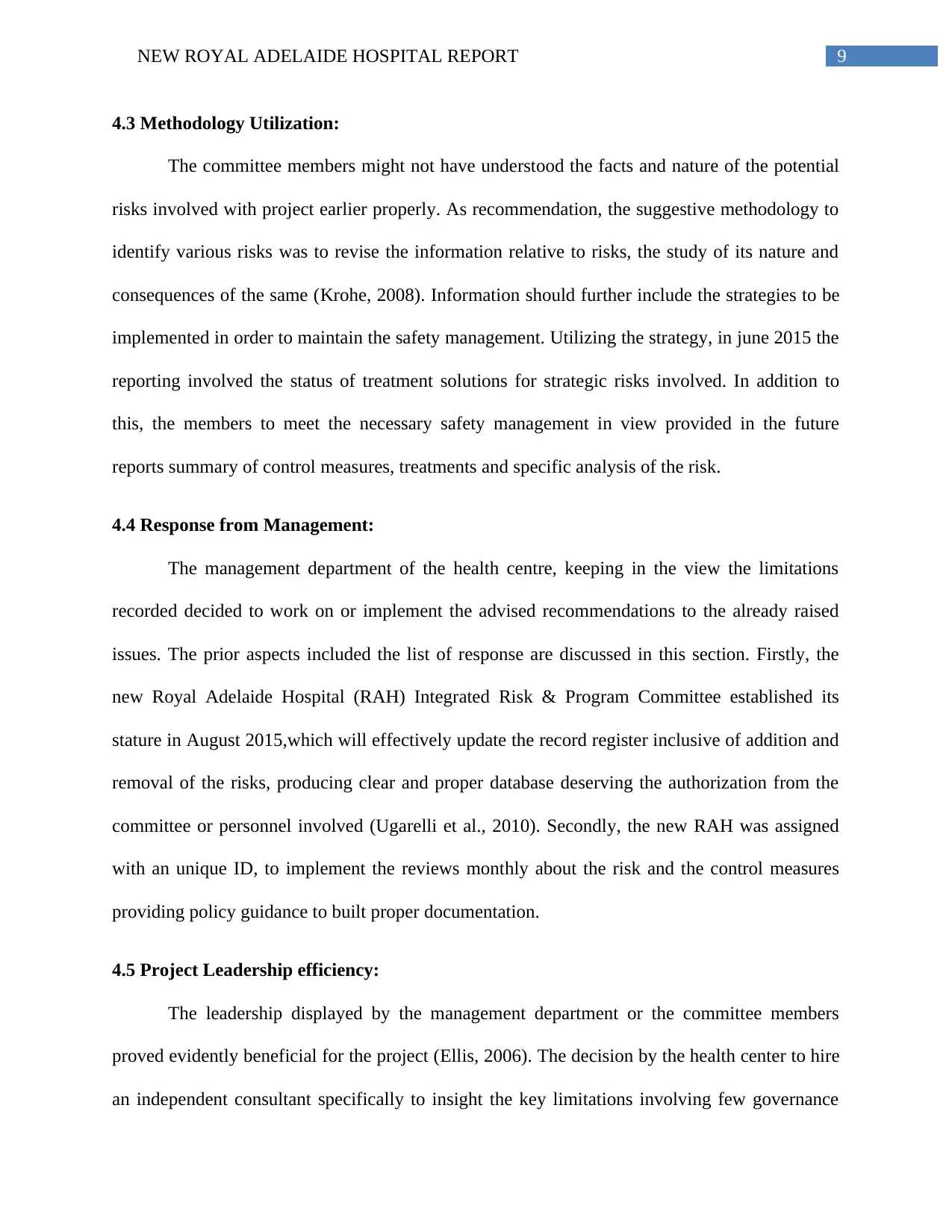
9NEW ROYAL ADELAIDE HOSPITAL REPORT
4.3 Methodology Utilization:
The committee members might not have understood the facts and nature of the potential
risks involved with project earlier properly. As recommendation, the suggestive methodology to
identify various risks was to revise the information relative to risks, the study of its nature and
consequences of the same (Krohe, 2008). Information should further include the strategies to be
implemented in order to maintain the safety management. Utilizing the strategy, in june 2015 the
reporting involved the status of treatment solutions for strategic risks involved. In addition to
this, the members to meet the necessary safety management in view provided in the future
reports summary of control measures, treatments and specific analysis of the risk.
4.4 Response from Management:
The management department of the health centre, keeping in the view the limitations
recorded decided to work on or implement the advised recommendations to the already raised
issues. The prior aspects included the list of response are discussed in this section. Firstly, the
new Royal Adelaide Hospital (RAH) Integrated Risk & Program Committee established its
stature in August 2015,which will effectively update the record register inclusive of addition and
removal of the risks, producing clear and proper database deserving the authorization from the
committee or personnel involved (Ugarelli et al., 2010). Secondly, the new RAH was assigned
with an unique ID, to implement the reviews monthly about the risk and the control measures
providing policy guidance to built proper documentation.
4.5 Project Leadership efficiency:
The leadership displayed by the management department or the committee members
proved evidently beneficial for the project (Ellis, 2006). The decision by the health center to hire
an independent consultant specifically to insight the key limitations involving few governance
4.3 Methodology Utilization:
The committee members might not have understood the facts and nature of the potential
risks involved with project earlier properly. As recommendation, the suggestive methodology to
identify various risks was to revise the information relative to risks, the study of its nature and
consequences of the same (Krohe, 2008). Information should further include the strategies to be
implemented in order to maintain the safety management. Utilizing the strategy, in june 2015 the
reporting involved the status of treatment solutions for strategic risks involved. In addition to
this, the members to meet the necessary safety management in view provided in the future
reports summary of control measures, treatments and specific analysis of the risk.
4.4 Response from Management:
The management department of the health centre, keeping in the view the limitations
recorded decided to work on or implement the advised recommendations to the already raised
issues. The prior aspects included the list of response are discussed in this section. Firstly, the
new Royal Adelaide Hospital (RAH) Integrated Risk & Program Committee established its
stature in August 2015,which will effectively update the record register inclusive of addition and
removal of the risks, producing clear and proper database deserving the authorization from the
committee or personnel involved (Ugarelli et al., 2010). Secondly, the new RAH was assigned
with an unique ID, to implement the reviews monthly about the risk and the control measures
providing policy guidance to built proper documentation.
4.5 Project Leadership efficiency:
The leadership displayed by the management department or the committee members
proved evidently beneficial for the project (Ellis, 2006). The decision by the health center to hire
an independent consultant specifically to insight the key limitations involving few governance
Paraphrase This Document
Need a fresh take? Get an instant paraphrase of this document with our AI Paraphraser
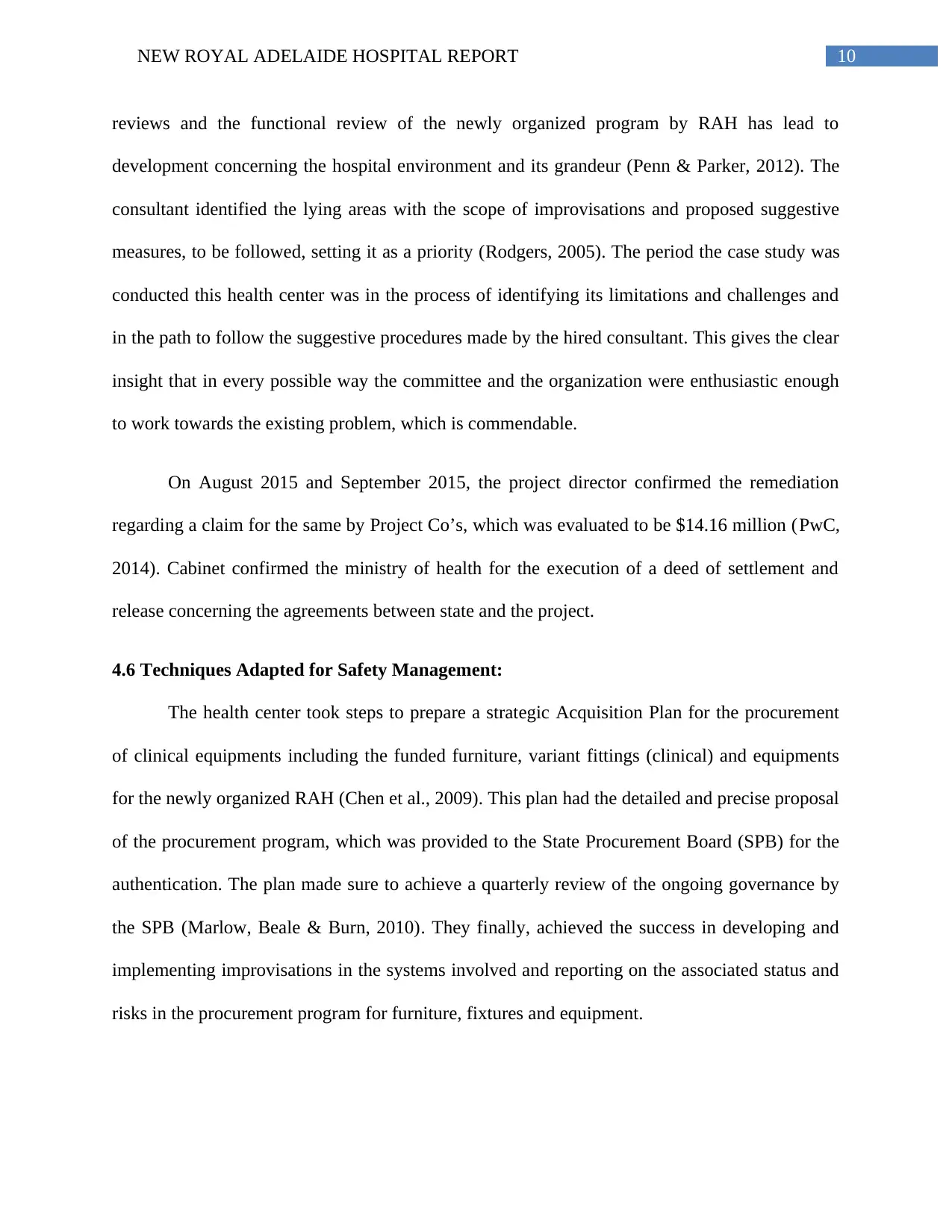
10NEW ROYAL ADELAIDE HOSPITAL REPORT
reviews and the functional review of the newly organized program by RAH has lead to
development concerning the hospital environment and its grandeur (Penn & Parker, 2012). The
consultant identified the lying areas with the scope of improvisations and proposed suggestive
measures, to be followed, setting it as a priority (Rodgers, 2005). The period the case study was
conducted this health center was in the process of identifying its limitations and challenges and
in the path to follow the suggestive procedures made by the hired consultant. This gives the clear
insight that in every possible way the committee and the organization were enthusiastic enough
to work towards the existing problem, which is commendable.
On August 2015 and September 2015, the project director confirmed the remediation
regarding a claim for the same by Project Co’s, which was evaluated to be $14.16 million (PwC,
2014). Cabinet confirmed the ministry of health for the execution of a deed of settlement and
release concerning the agreements between state and the project.
4.6 Techniques Adapted for Safety Management:
The health center took steps to prepare a strategic Acquisition Plan for the procurement
of clinical equipments including the funded furniture, variant fittings (clinical) and equipments
for the newly organized RAH (Chen et al., 2009). This plan had the detailed and precise proposal
of the procurement program, which was provided to the State Procurement Board (SPB) for the
authentication. The plan made sure to achieve a quarterly review of the ongoing governance by
the SPB (Marlow, Beale & Burn, 2010). They finally, achieved the success in developing and
implementing improvisations in the systems involved and reporting on the associated status and
risks in the procurement program for furniture, fixtures and equipment.
reviews and the functional review of the newly organized program by RAH has lead to
development concerning the hospital environment and its grandeur (Penn & Parker, 2012). The
consultant identified the lying areas with the scope of improvisations and proposed suggestive
measures, to be followed, setting it as a priority (Rodgers, 2005). The period the case study was
conducted this health center was in the process of identifying its limitations and challenges and
in the path to follow the suggestive procedures made by the hired consultant. This gives the clear
insight that in every possible way the committee and the organization were enthusiastic enough
to work towards the existing problem, which is commendable.
On August 2015 and September 2015, the project director confirmed the remediation
regarding a claim for the same by Project Co’s, which was evaluated to be $14.16 million (PwC,
2014). Cabinet confirmed the ministry of health for the execution of a deed of settlement and
release concerning the agreements between state and the project.
4.6 Techniques Adapted for Safety Management:
The health center took steps to prepare a strategic Acquisition Plan for the procurement
of clinical equipments including the funded furniture, variant fittings (clinical) and equipments
for the newly organized RAH (Chen et al., 2009). This plan had the detailed and precise proposal
of the procurement program, which was provided to the State Procurement Board (SPB) for the
authentication. The plan made sure to achieve a quarterly review of the ongoing governance by
the SPB (Marlow, Beale & Burn, 2010). They finally, achieved the success in developing and
implementing improvisations in the systems involved and reporting on the associated status and
risks in the procurement program for furniture, fixtures and equipment.
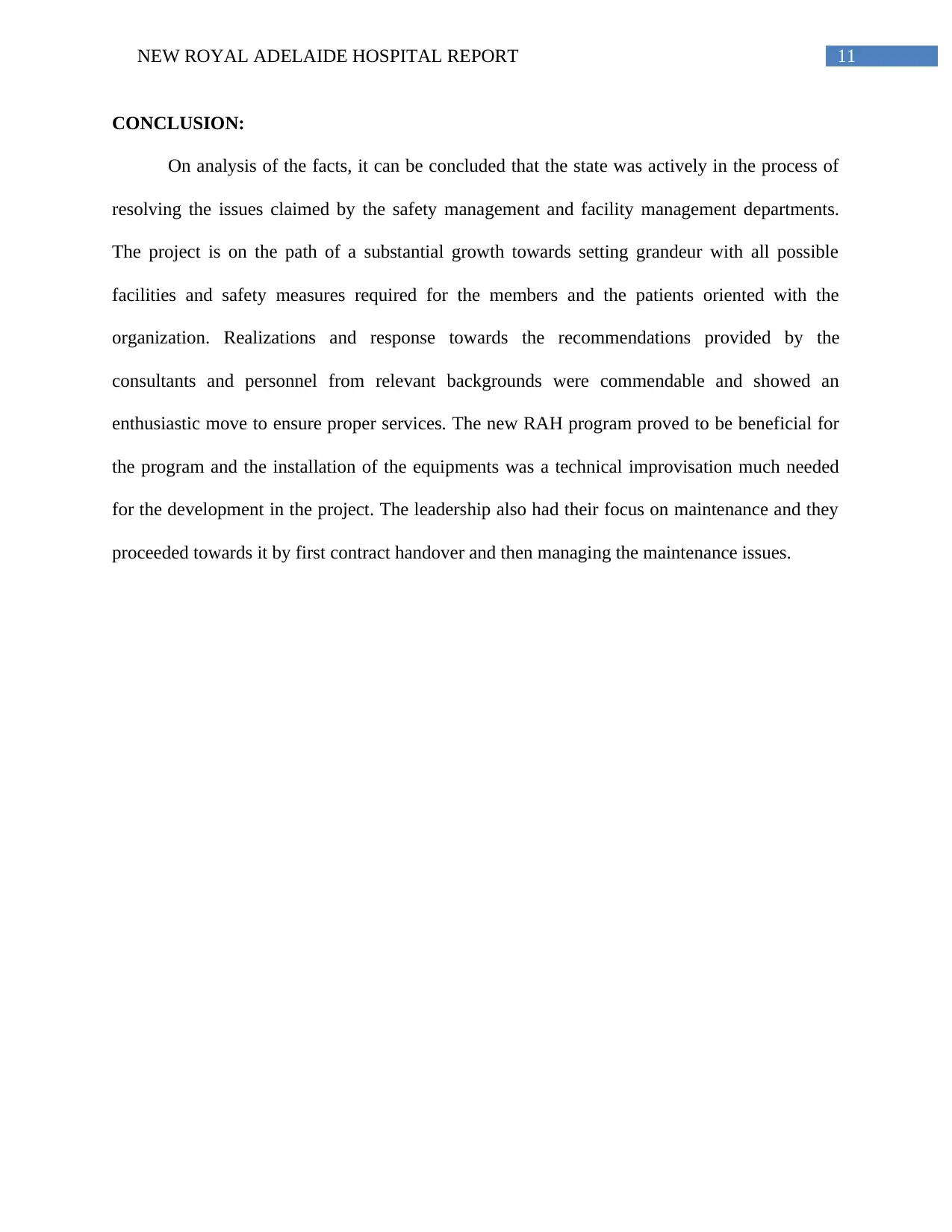
11NEW ROYAL ADELAIDE HOSPITAL REPORT
CONCLUSION:
On analysis of the facts, it can be concluded that the state was actively in the process of
resolving the issues claimed by the safety management and facility management departments.
The project is on the path of a substantial growth towards setting grandeur with all possible
facilities and safety measures required for the members and the patients oriented with the
organization. Realizations and response towards the recommendations provided by the
consultants and personnel from relevant backgrounds were commendable and showed an
enthusiastic move to ensure proper services. The new RAH program proved to be beneficial for
the program and the installation of the equipments was a technical improvisation much needed
for the development in the project. The leadership also had their focus on maintenance and they
proceeded towards it by first contract handover and then managing the maintenance issues.
CONCLUSION:
On analysis of the facts, it can be concluded that the state was actively in the process of
resolving the issues claimed by the safety management and facility management departments.
The project is on the path of a substantial growth towards setting grandeur with all possible
facilities and safety measures required for the members and the patients oriented with the
organization. Realizations and response towards the recommendations provided by the
consultants and personnel from relevant backgrounds were commendable and showed an
enthusiastic move to ensure proper services. The new RAH program proved to be beneficial for
the program and the installation of the equipments was a technical improvisation much needed
for the development in the project. The leadership also had their focus on maintenance and they
proceeded towards it by first contract handover and then managing the maintenance issues.
⊘ This is a preview!⊘
Do you want full access?
Subscribe today to unlock all pages.

Trusted by 1+ million students worldwide
1 out of 15
Related Documents
Your All-in-One AI-Powered Toolkit for Academic Success.
+13062052269
info@desklib.com
Available 24*7 on WhatsApp / Email
![[object Object]](/_next/static/media/star-bottom.7253800d.svg)
Unlock your academic potential
Copyright © 2020–2025 A2Z Services. All Rights Reserved. Developed and managed by ZUCOL.





